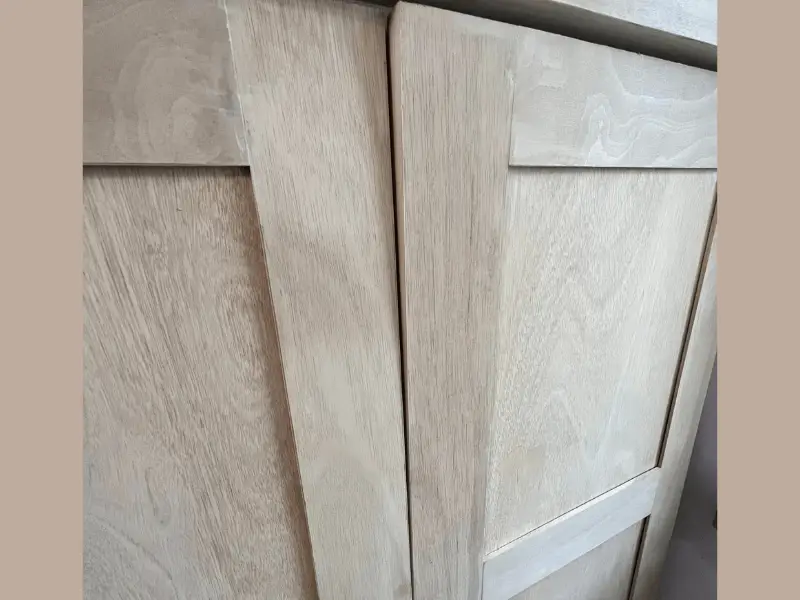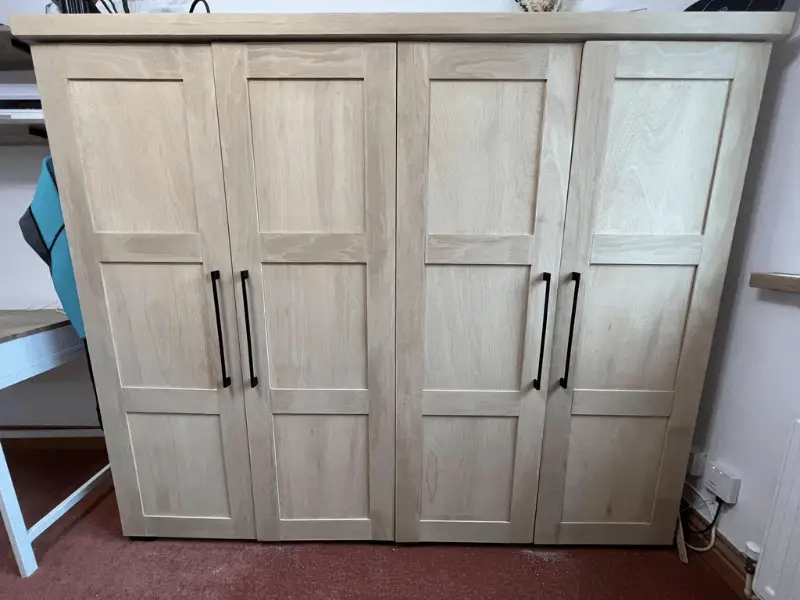Nothing can be more gratifying than the labor of our hands turning simple materials into functional, beautiful pieces. However, like with any creative endeavor, we also face challenges. One such challenge is keeping plywood door panels from warping, which can affect your door’s functionality and look.
Warping is a common issue with plywood doors, despite plywood’s excellent reputation for stability relative to other wood types. Therefore, understanding why plywood warps and implementing preventive measures are crucial to building a sturdy, long-lasting door that maintains a flat surface.
In the following sections, you will learn about the causes of warping, the best ways to prevent warping, and choosing suitable plywood.
What Causes Plywood to Warp?
The warping of plywood is a common issue that woodworkers encounter, mainly when dealing with plywood doors. However, you might ask yourself why this plywood even warped in the first place. Well, plywood warping is primarily driven by variations in moisture levels within the plywood itself.
Essentially, as plywood absorbs moisture, it expands. On the other hand, when it releases water, it shrinks. If one side of the plywood absorbs or releases moisture at a different rate, this can lead to warping. The side that absorbs more moisture expands, causing the entire sheet to bend or twist. This is known as ‘cupping’ or ‘bowing.’
Environmental factors also play a significant role in causing plywood to warp. High humidity, drastic changes in temperature, and prolonged exposure to water can compromise the structural integrity of your plywood doors, leading to their warping. Plywood is particularly susceptible to this warping phenomenon if not treated or sealed correctly.
How to Keep Plywood Doors From Warping

Keeping plywood doors from warping might seem daunting, but it’s more than achievable with the proper guidance. Here, you’re about to discover straightforward strategies to prevent warping and keep your doors looking fabulous for their lifespan.
1. Preventing Moisture Damage by Sealing Plywood Edges
Keeping plywood doors from warping lies in protecting the edges against moisture infiltration. Plywood edges are more susceptible to this damage because they absorb water more rapidly than the surface. By sealing these edges, you can effectively reduce the chance of warping. However, before beginning the sealing process, choosing the right type of sealer for your plywood doors is vital. Polyurethane, lacquer, or varnish are all excellent options for this purpose. These sealers are known for their durability and capability to offer a robust protective guard against moisture.
2. Applying Varnish or Paint to Protect Plywood Doors
Applying varnish or paint is a powerful way to keep your plywood doors from warping. This adds an element of visual appeal and provides a protective coating that can shield the plywood from the harmful effects of excessive moisture and temperature changes.
Plywood doors lend themselves well to many types of varnish and paint. A high-quality, water-based polyurethane varnish is typically a good choice. It provides a clear, long-lasting finish that does not turn yellow over time. As for paint, it’s wise to opt for a high-gloss type, which can handle high moisture levels better than its flat or matte counterparts.
3. Using Plywood with Proper Thickness and Layering
Thin plywood often tends to warp more efficiently than its thicker counterparts. This is due to the flimsier construction, which allows more movement and flexibility, resulting in distortion over time.
So, when choosing plywood for doors, look for thicknesses ranging from 3/4 inches to an inch. These thick boards will provide better resistance against warpage.
Now, let’s talk about layering. Plywood is constructed from multiple layers (or ‘plies’) of wood veneer that are glued together in a process involving heat and pressure. The grains of each layer are perpendicular to each other, which helps increase strength and stability, reducing the risk of warping.
An important tip is that the more layers, the less chance of warping there is. Therefore, high-quality plywood with more layers will stay flat and stable, effectively preventing warping.
Beyond these benefits, layers also contribute to a pleasant aesthetic when the plywood edges are visible in the design of the door. A well-made piece of plywood with many layers will exhibit an attractive, striped edge.
To summarize, investing in thicker, high-quality plywood with multiple layers will contribute to the longevity of your doors and enhance their beauty. So choose wisely!
Read Next
• How to Treat Plywood for Outdoor Use
• Best Plywood for Shelves
• Sande Plywood: An Overview
• Best Primer for Plywood
• How to Treat Pine Logs for Outdoor Use
4. Avoiding Direct Exposure to Sunlight and Extreme Temperatures
Direct sunlight, as well as high temperatures, can cause the moisture within the plywood to evaporate too rapidly, which could lead to uneven drying and, hence, warping. Alternatively, freezing temperatures can negatively affect your doors by making them brittle and more susceptible to warping.
5. Tightening Loose Screws and Hinges to Keep Doors Aligned
Over time, the screws and hinges that hold your plywood doors in place may loosen due to use and natural wear and tear. This could cause your doors to misalign or warp. Therefore, it’s essential to check and tighten them as needed periodically, but with care, since overtightening can be just as damaging.
Choosing the Right Plywood for Your Doors
When it comes to choosing plywood for doors,consider the following factors, as they will significantly increase the longevity of your plywood doors and enhance their appearance.
1. Quality
Quality is paramount when selecting plywood for your doors. Always go for high-quality plywood, even if it’s a little more expensive. It’s an investment that pays off remarkably well in the long run, as higher-quality plywood tends to resist warping better than its cheaper counterparts.
2. Plywood Thickness and Layers
The thickness and layers of the plywood also play a crucial role. Thicker plywood with more layers tends to be more stable and resistant to warping. Plywood on the market usually ranges from 1/8 inch to 3/4 inch thick. Still, 1/2 inch or thicker is often a good choice for doors.
3. Type of Plywood
The type of plywood is also valuable. Certain types of plywood, such as marine or exterior-grade plywood, come with added properties that make them more resilient to warping caused by humidity and temperature fluctuations. Marine plywood is especially noted for its moisture resistance and would suit doors in high-humidity areas.
4. Automotive and Veneer Plywood
Another remarkable option is automotive plywood. This plywood type, often utilized in the automotive industry, is highly durable and resistant to warping. Alternatively, you can also consider doors made from veneer plywood; they are attractive and generally warp-resistant, mainly when they consist of tightly bonded multiple veneer layers. While this does not eliminate the risk of warping entirely, it can significantly reduce it.
Note: The cost may increase with the increasing quality of plywood, but remember, a higher initial investment can save you a lot in the long run. Thus, making thoughtful decisions is wiser than facing a warped door later.
Selecting the plywood for your doors involves considering its quality, thickness, layers, type, and budget. By making a thoughtful decision about these factors, you will significantly increase the lifespan of your plywood doors and keep them from warping.
Conclusions
In conclusion, properly maintaining the health of your plywood doors entails a comprehensive understanding of the factors that cause warping and the protective measures to take against them. With the proper awareness, care, and maintenance, plywood doors can be a durable, attractive addition to your home or project for years. Whether you are a beginner or a seasoned woodworker, every successful project involves continuous learning and adaptation to your specific environment and needs.

